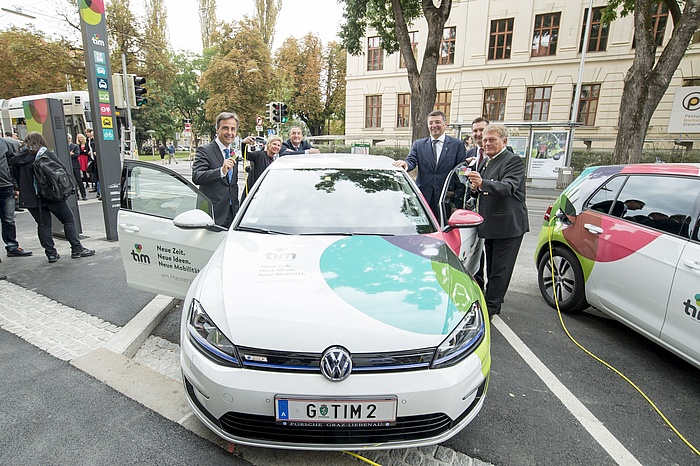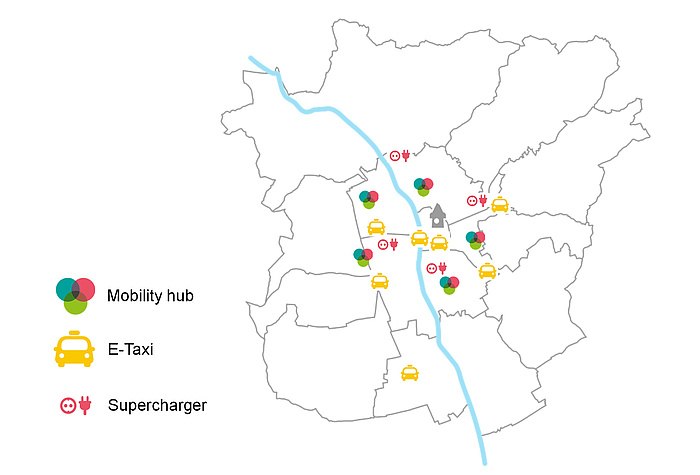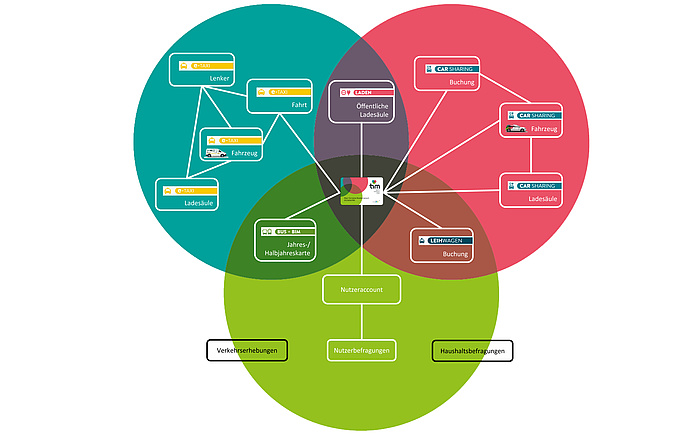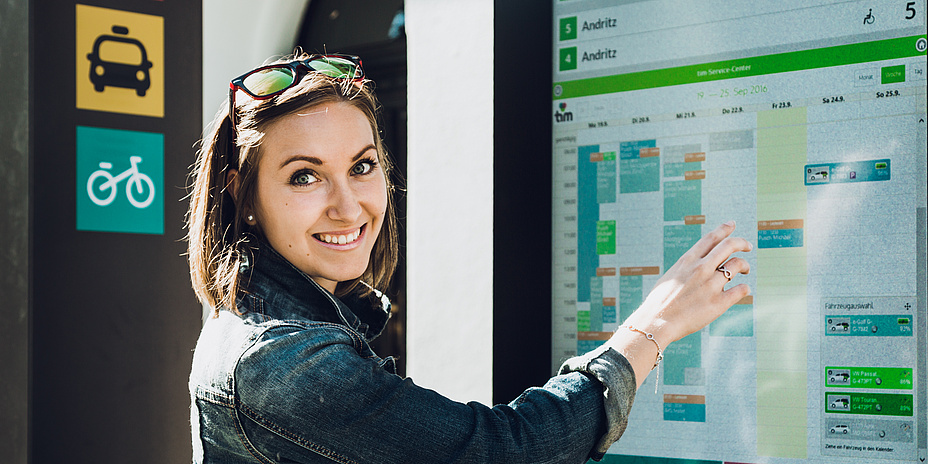A few weeks ago the first “tim” location was opened on Graz’s Hasnerplatz – “tim” stands for “täglich.intelligent.mobil” (daily.intelligent.mobile). The new mobility offer from Holding Graz wants to link together various ways of travel using multi-modal nodes and combine them for people who need a fast and uncomplicated means of transport. The location has been chosen in the direct vicinity of the tram line and offers ample bicycle parking after the rebuilding phase. Directly next to it, at the exclusive EV-taxi stand, the EV-taxis operating in Graz since April can be used and paid for without cash in a collective invoice using the tim card. Also, as an alternative to your own car, vehicles can be booked for a shorter or longer time directly at the terminal or by means of an online platform. If you want to use a car for up to one day, for instance, to go shopping, conventional or EV-car sharing is ideal.

Opening of the first tim-location at Graz´s Hasnerplatz.
For longer periods of time, for instance – for going on holiday, hire cars are available at favourable rates and can also be easily booked online. The choice is simple for the user. He or she simply enters the desired period and the system suggests the most economical variant automatically. The mobility offer is completed by providing EV charging stations for persons who already own an eco-friendly electric vehicle.
From test to regular operation
Currently, the only terminal is at Hasnerplatz, but more terminals are being planned for the coming years at Schillerplatz, at the Trade Fair, in the Smart City and at Reininghaus. “And of course we’re hoping that demand will be so big that they’ll be many more,” says Birgit Kohla, with her eye on the future. The scientist from TU Graz’s Institute of Highway Engineering and Transport Planning (ISV) is responsible for the scientific support of the project which is now going from testing to regular operation.

There should not be only one tim-location in Graz – more are already planned.
The Institute of Highway Engineering and Transport Planning, the Institute of Automotive Engineering and the Institute of Urbanism are all involved in the project at TU Graz. Outside the University, the Quintessenz company is responsible for surveys of the users and FH Joanneum University of Applied Sciences supports marketing as a partner. The project was commissioned by Holding Graz, which also builds and operates the multi-modal nodes. The concept originated in the course of the Smart City Graz project, for which there was a special “mobility” work package in which innovative and sustainable transport systems were meant to be conceived. Among other things, an idea came about for a combined sharing offer which provides many different types of mobility in one location. The implementation concept and design was developed in a student competition by TU Graz and FH Joanneum and has now been put into action with the first node at Hasnerplatz.
Who, when and why?
“Now is the time to find out who uses the mobility offer (and who doesn’t) and when and why; what CO2 savings can be achieved and what it can contribute to the reduction of particulate matter,” explains Birgit Kohla. A broad range of data generated by GPS tracking, 3D simulations, questionnaires and observations will be evaluated. The environment of the multi-modal nodes is being investigated by the Institute itself. An important point in the project is how the daily mobility behaviour of persons who make use of the mobile offer will change and what effects these changes will have. The project startet in July 2015 and up until now very important data to compare with the new data was collected. “Master’s students researched mobility behaviour at the nodes before the sharing offer was introduced. So we now have a lot of data to compare with.” It’s also very important to find out whether and how the mobile offer is used by various age groups. Now, after the car sharing was implemented, the collection of new data started. Whether, for instance, elderly people have fundamental problems with the systems which are designed according to the latest technology. “To sum up, I’m waiting to find out whether the mobile offer – as it stands – is attractive or not. And especially for whom it is attractive and why.”

A broad range of data generated by GPS tracking, 3D simulations, questionnaires and observations will be evaluated.
And on the basis of these findings the team will make suggestions for improvement or expansion. “We can, for instance, well imagine a bicycle hire system which hasn’t yet been used in Graz. Or perhaps instead of car sharing, people would prefer a chauffeur service, which can take you to the doctor, for instance, or bring the shopping home. Who knows? In any event, I’m very curious.” The results will be made available in 2018.
This research area is anchored in the Field of Expertise "Sustainable Systems", one of five research foci of TU Graz.
Birgit KOHLA
Dipl.-Ing. Dr.nat.techn.
Institute of Highway Engineering and Transport Planning
Rechbauerstraße 12
8010 Graz, Austria
Phone: +43 316 873 6722
<link int-link-mail window for sending>birgit.kohla@tugraz.at








